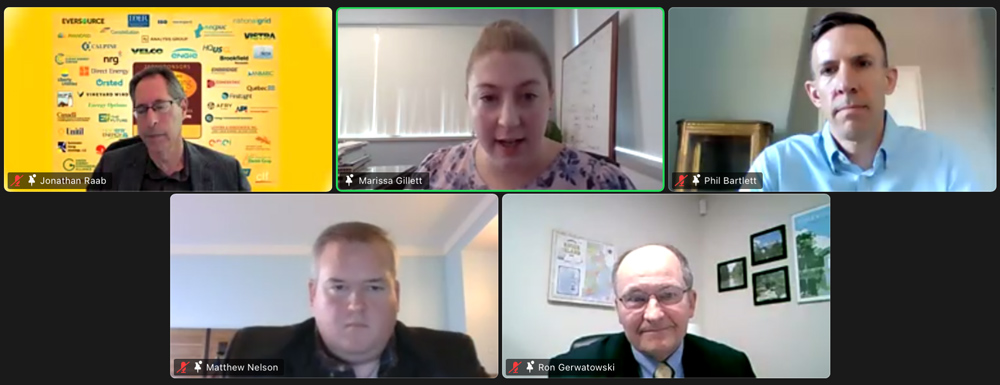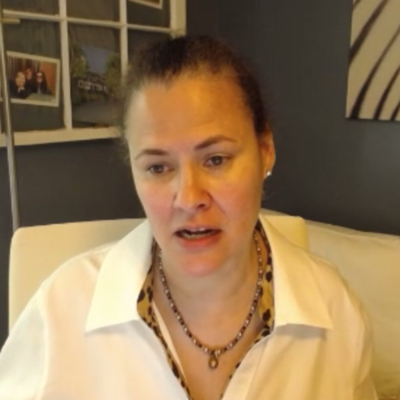More than 425 people registered for Raab Associates’ 170th New England Electricity Restructuring Roundtable last week to hear a panel discussion about the role of utility regulation in decarbonizing the region, in addition to a keynote speech from Acting Assistant Secretary of Energy Kelly Speakes-Backman.
Here is some of what we heard during the virtual event hosted by Boston law firm Foley Hoag.
Advanced Metering Emerges as Priority
Massachusetts has been working on adopting advanced metering infrastructure (AMI) for almost a decade, but new improvements in metering technology have created consumer friendly features that increase access through devices such as smartphones.
The state’s Department of Public Utilities (DPU) is looking into opportunities for a “more traditional investment” in AMI to support grid modernization, instead of a program that serves as a pilot, Chairman Matthew Nelson said.
Utilities in Massachusetts are required to file their grid modernization plans to DPU on July 1, and Nelson said they must “take advantage of advancements in metering technology.”
AMI is an integrated system of smart meters, communication networks and data management systems that allows utilities to measure electricity use automatically and remotely, connect or disconnect service, monitor voltage and communicate with customers. The technology allows utilities to offer new time-based rates that encourage customers to reduce peak demand and manage energy consumption and costs.
National Grid, one of the utilities in Massachusetts, had previously submitted a plan for AMI in Rhode Island but subsequently sold its business there to PPL Corp. in Pennsylvania.
Central Maine Power has already implemented an early AMI system. The Maine Public Utilities Commission is assessing any changes that are needed to the system, Chair Phil Bartlett said.
“As people invest in EVs, this is the optimal time to implement time-use rates,” he said.

Maine is working on developing time-use rates, Bartlett said, but the commission doesn’t want to impose them on the public until it has more information about how the system in southern Maine is going.
The DPU in Massachusetts is also being cautious in rolling out time-use rates for residents, despite its success with time-use rates on the retail supplier side, Nelson said. The agency would deploy AMI to all customers, including municipal aggregators.
“To replicate that on the residential side has to be done very carefully,” Nelson said. “We don’t want to artificially raise rates if we aren’t seeing a reduction in peak demand.”
A report on AMI from the Department of Energy in 2016 found that over a three-year period, 19 AMI projects saved $316 million in operations and management costs, or $16.6 million per project. The AMI technology also saved an estimated 15,160 tons of carbon dioxide emissions.
But Marissa Gillett, chair of Connecticut’s Public Utilities Regulatory Authority, said her agency is also taking a cautious approach.
“Any time we ask customers to change their behavior, we need to have a grasp on what they need to change and how,” Gillett said at the panel. “But [time-use rates] are not off the table in Connecticut.”
Northeast Expected ‘Epicenter’ of OSW Development
Speakes-Backman said that President Biden’s clean-energy goals put the United States on an “irreversible path” to achieving a decarbonized power sector by 2035 and net-zero emissions economywide no later than 2050.
“This is the most ambitious climate strategy our nation has ever had, and we have no time to waste to get it into play,” said Speakes-Backman, who works in the Office of Energy Efficiency and Renewable Energy.
She said her office’s FY2022 budget request of $4.73 billion focuses on energy efficiency, sustainable transportation and renewable power, notably offshore wind.

“The fastest and most cost-effective way we know to decarbonize the economy is to first prioritize the transition to a carbon-free power sector,” Speakes-Backman said. “We need to integrate more renewable energy generation onto the grid while still ensuring that it’s reliable and secure.”
The Biden administration has a stated goal to build 30 GW of OSW by 2030. Speakes-Backman said projects like the recently approved Vineyard Wind I have the Northeast poised to be “the epicenter of near-term OSW development in the U.S.”
Connecticut, Massachusetts and Rhode Island have procured OSW to support their decarbonization targets. Speakes-Backman said that the Gulf of Maine could be used to support the deployment of next-generation floating wind technologies.
“The waters are too deep for traditional fixed-bottom foundations to be economical, so we’re leading efforts to design, test and demonstrate floating foundations to harness OSW in these deep-water areas, which account for about 60% of our OSW resources across the country,” she said.
Floating OSW technology, she added, is “nascent,” and there are many “opportunities to improve.”
From a research and development perspective, Speakes-Backman said her office has been working with the University of Maine on a proposed OSW demonstration project using semi-submersible concrete floating foundations developed by the university. There is also a new partnership with Atkins Global to demonstrate floating OSW technology previously used by offshore oil and gas, with a plan for installation at one of the Mayflower Winds lease areas south of Martha’s Vineyard and Nantucket. Additionally, there is support for several projects at the National Offshore Wind Research and Development Consortium, a public-private endeavor to address technological barriers and lower OSW costs and risks.
When asked how to mitigate the potential costs to ratepayers for major investments in transmission to meet OSW goals in New England, which could hamper electrification efforts, Speakes-Backman said that any work done now would drive down future costs.
“First, let’s examine the supposition that renewable power is so much more expensive than other traditional resources, as I think the costs are coming down quickly,” Speakes-Backman said. “The work that we’re doing is really to bring those costs down even further. Also, the investment that the federal government is doing to help states, or that we are looking to do in FY22, will help to suppress the costs.”



